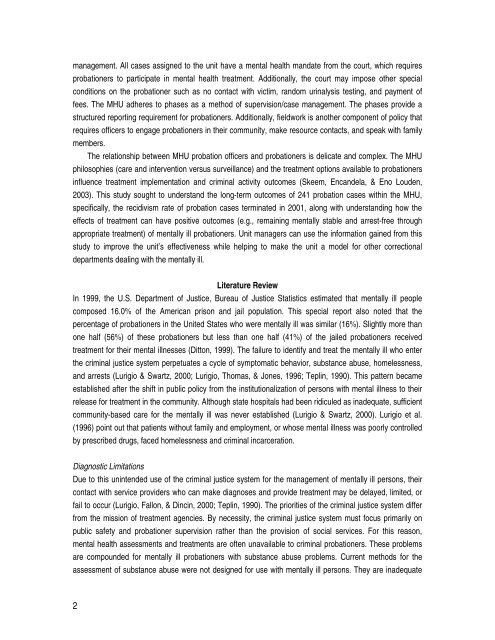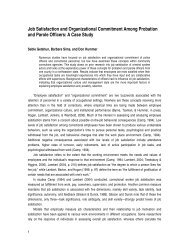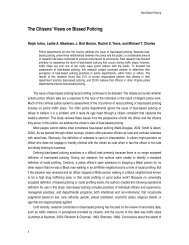Adult Probation Department Mental Health Unit: An Outcomes ...
Adult Probation Department Mental Health Unit: An Outcomes ...
Adult Probation Department Mental Health Unit: An Outcomes ...
- No tags were found...
Create successful ePaper yourself
Turn your PDF publications into a flip-book with our unique Google optimized e-Paper software.
management. All cases assigned to the unit have a mental health mandate from the court, which requiresprobationers to participate in mental health treatment. Additionally, the court may impose other specialconditions on the probationer such as no contact with victim, random urinalysis testing, and payment offees. The MHU adheres to phases as a method of supervision/case management. The phases provide astructured reporting requirement for probationers. Additionally, fieldwork is another component of policy thatrequires officers to engage probationers in their community, make resource contacts, and speak with familymembers.The relationship between MHU probation officers and probationers is delicate and complex. The MHUphilosophies (care and intervention versus surveillance) and the treatment options available to probationersinfluence treatment implementation and criminal activity outcomes (Skeem, Encandela, & Eno Louden,2003). This study sought to understand the long-term outcomes of 241 probation cases within the MHU,specifically, the recidivism rate of probation cases terminated in 2001, along with understanding how theeffects of treatment can have positive outcomes (e.g., remaining mentally stable and arrest-free throughappropriate treatment) of mentally ill probationers. <strong>Unit</strong> managers can use the information gained from thisstudy to improve the unit’s effectiveness while helping to make the unit a model for other correctionaldepartments dealing with the mentally ill.Literature ReviewIn 1999, the U.S. <strong>Department</strong> of Justice, Bureau of Justice Statistics estimated that mentally ill peoplecomposed 16.0% of the American prison and jail population. This special report also noted that thepercentage of probationers in the <strong>Unit</strong>ed States who were mentally ill was similar (16%). Slightly more thanone half (56%) of these probationers but less than one half (41%) of the jailed probationers receivedtreatment for their mental illnesses (Ditton, 1999). The failure to identify and treat the mentally ill who enterthe criminal justice system perpetuates a cycle of symptomatic behavior, substance abuse, homelessness,and arrests (Lurigio & Swartz, 2000; Lurigio, Thomas, & Jones, 1996; Teplin, 1990). This pattern becameestablished after the shift in public policy from the institutionalization of persons with mental illness to theirrelease for treatment in the community. Although state hospitals had been ridiculed as inadequate, sufficientcommunity-based care for the mentally ill was never established (Lurigio & Swartz, 2000). Lurigio et al.(1996) point out that patients without family and employment, or whose mental illness was poorly controlledby prescribed drugs, faced homelessness and criminal incarceration.Diagnostic LimitationsDue to this unintended use of the criminal justice system for the management of mentally ill persons, theircontact with service providers who can make diagnoses and provide treatment may be delayed, limited, orfail to occur (Lurigio, Fallon, & Dincin, 2000; Teplin, 1990). The priorities of the criminal justice system differfrom the mission of treatment agencies. By necessity, the criminal justice system must focus primarily onpublic safety and probationer supervision rather than the provision of social services. For this reason,mental health assessments and treatments are often unavailable to criminal probationers. These problemsare compounded for mentally ill probationers with substance abuse problems. Current methods for theassessment of substance abuse were not designed for use with mentally ill persons. They are inadequate2
















